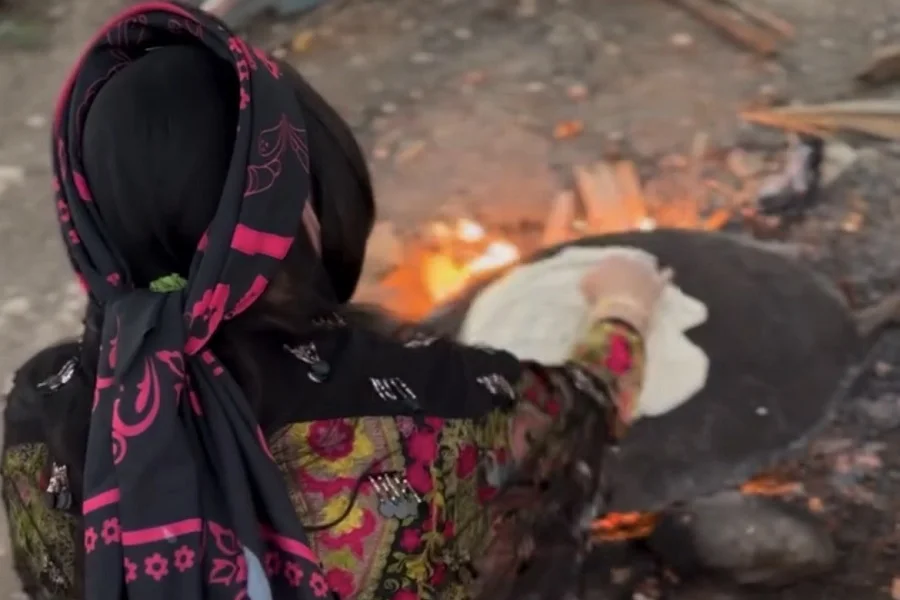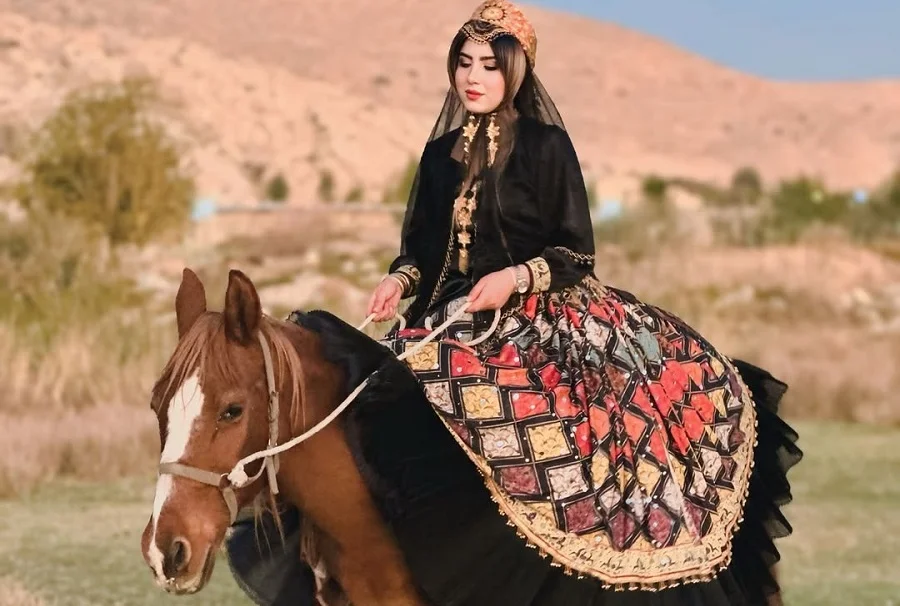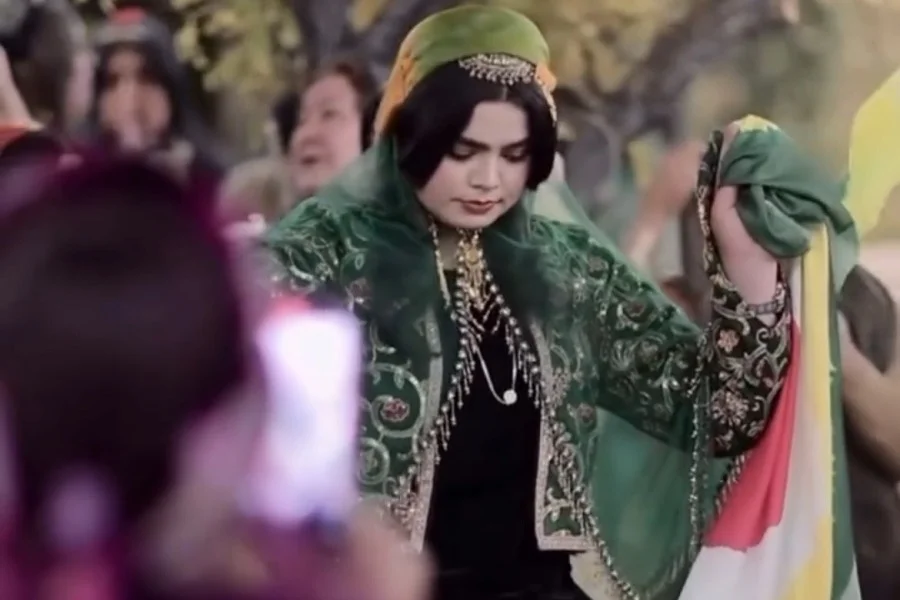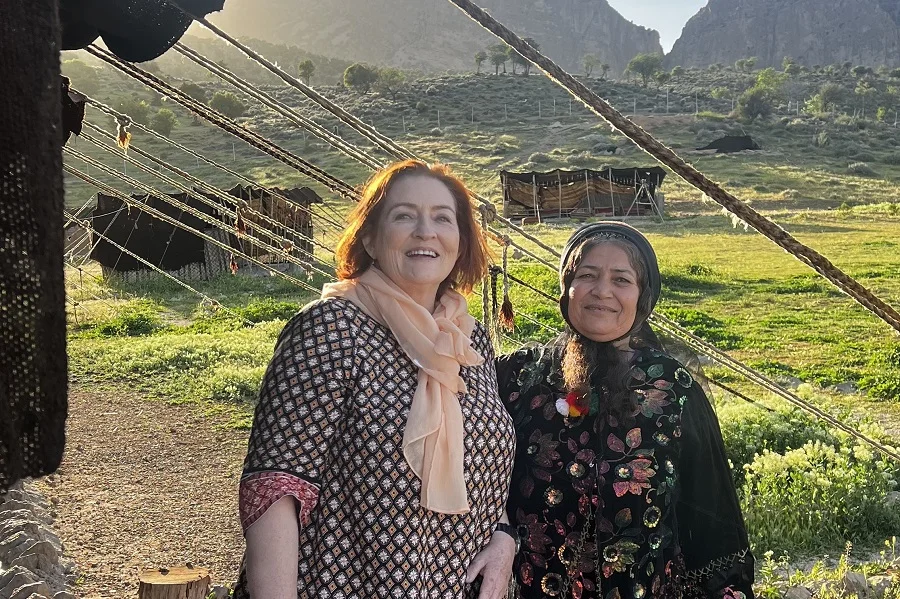
Qashghai Nomads
The Qashqai tribe is considered one of the largest and most populous Iranian tribes and has played an important role in the history of Iran.
The Qashqai tribe is one of the most populous tribes in Iran. They are considered part of the Turkic tribes of the Qipchaq steppe, who later migrated to India, Iraq, and Sistan, and eventually settled in the Fars province.
Despite the passage of time and the rise of modern culture, the Qashqai have preserved their customs and traditions and continue to enjoy living in nature.
Living in siah chador (traditional black tents), their unique tribal music, lifestyle, traditional foods, and distinctive customs are among the most important characteristics of the Qashqai tribe.
The origin of the Qashqai tribe
Because of its unique geographical location, Iran was known as the bridge between the East and the West and played a major role in the history of the Middle East.
Ancient Iran stretched from the Indus River in India to the east, Mesopotamia to the west, the Oxus River, the Caspian Sea, and the Caucasus to the north, and the Persian Gulf and the Sea of Oman to the south, covering an area of about 2,600,000 square kilometers.
Throughout history, many ethnic groups have flourished within the geography of Iran. One of these groups is the Qashqai people, who, according to historical sources, migrated from the regions along the borders of Turkestan, which were under Iranian influence, and settled on the Iranian plateau.
Studying the sources related to the Qashqai tribe shows that this group once lived in a land called “Qashq,” and belonged to a clan known as “Qashqeh.” There was also a river near their homeland called “Qashqa.”
They spoke the Turkic language with the Qashqeh dialect and lived in the regions of Turkestan and Uzbekistan. Over different historical periods, the Qashqai migrated into Iran and settled there. After settling in Iran, they brought many other groups along with them.
There are various accounts regarding the origin of the Qashqai people. During the reign of Shah Ismail Safavid, a group under the command of Amir Ghazi Shahi-Lu, who was Qashqai, came to the region of Fars to promote the Shi’a faith. By forming an alliance with other nomadic groups of the area, they established the Qashqai tribe.

History of the Qashqai Tribe
The leaders of the Qashqai tribe belonged to the Shahilu clan. The first leader of the tribe was Amir Ghazi Shahilu. He lived in the village of Darvish and was greatly respected and revered by the people. Even today, people visit his tomb in the village of Darvish for pilgrimage.
According to historical accounts, Amir Ghazi assisted Shah Ismail Safavid in establishing the Shi’a faith. Looking at history, we see that it was at the beginning of the 18th century that the Qashqai began to show their influential role in the history of Fars.
In the 18th century, a man named Jan Mohammad Agha, also known as Jani Agha, was the leader of the Qashqai tribe. According to historical accounts from this period, his sons, Esmail Khan and Hassan Khan, played an influential role in Nader Shah’s conquest of India.
However, over time, the tribe fell out of favor with Nader Shah, and he ordered Esmail Khan to be blinded. From that point on, he became known as “Esmail the Blind Qashqai.”
This event forced the Qashqai to migrate to Daregaz, Kalat-e Naderi, and Sarakhs in Khorasan. Saeed Nafisi writes in his book The Contemporary History of Iran:
With the rise of Karim Khan Zand, Esmail Khan wrote to him, requesting permission to return to his tribe in Fars. Karim Khan accepted his request, and the Qashqai returned to Fars. After that, Esmail Khan became one of Karim Khan’s trusted allies.
Some believe that the person standing next to Karim Khan Zand in his portrait, who appears to be blind, is Esmail Khan. This painting is kept in the British Museum.
During the turbulent period following the death of Karim Khan Zand, Esmail Khan, due to his connection with Zaki Khan, claimed the governorship of Fars. After Zaki Khan was killed, Esmail Khan was executed.
Esmail Khan’s son, Jan Mohammad Khan, also known as Jani Khan, succeeded him as the leader of the Qashqai tribe. He was a supporter of Jafar Khan Zand. When Agha Mohammad Khan Qajar came to power, he attacked the Qashqai, but they took refuge in the mountains and survived.
Agha Mohammad Khan sent part of the Qashqai tribe to northern Iran. Earlier, during the reign of Karim Khan Zand, many Lur and Kurdish clans who had come to Shiraz with Karim Khan had merged with the Qashqai, significantly increasing the tribe’s population.
After Jani Khan, his son Mohammad Ali succeeded him. Jani Khan was the first among the Qashqai to use the title Ilkhan for himself, and his successors continued to use this title.
Although Mohammad Ali Khan was ill for much of his life, he held significant power and brought not only the Qashqai but also other major tribes of Fars under his control. He maintained very good relations with the Qajar tribe and married the daughter of Hossein Ali Mirza Farmanfarma, who was the governor of Fars at that time.
After the death of Mohammad Ali Khan, his brother Mohammad Qoli Khan succeeded him. After that, five districts of Shiraz, which opposed Ebrahim Khan Kalantar, allied with the Qashqai, increasing the tribe’s power.
At the same time, the Bakhtiari and other groups were preoccupied with internal conflicts, allowing the Qashqai tribe to gain the greatest power.
The Qajar government appointed Ali Mohammad Khan Qavam-ol-Moluk as governor of Fars and allied with the Khamseh tribe against the Qashqai. At this time, Sultan Mohammad succeeded his father as Ilkhan of the Qashqai, but he was an inexperienced and alcoholic leader who, despite famine and hardships, failed to manage the tribe. His incompetence led to the collapse of Qashqai power, and around five thousand households joined the Bakhtiari tribe.
With the rise of Esmail Khan Solat-od-Dowleh to the position of Ilkhan in 1904, the Qashqai regained their strength, and during the weakened state of the central government under Mozaffar-od-Din Shah, he gained significant influence in Shiraz and the tribal regions.
The Qashqai Tribe during the era of Solat-od-Dowleh
When the Constitutional Revolution took place in Iran, Fars fell into turmoil. Since the Qavam family and their supporters backed the monarchists, the Qashqai joined the constitutionalists. When the Bakhtiari forces took control of Tehran, the Qavam family aligned with them. In response, Solat-od-Dowleh formed an alliance with Sheikh Khazal and Sardar Ashraf against the Qavam family and the Bakhtiari.
A civil war broke out in Fars, and Britain, having monopolized the oil of Khuzestan, felt threatened by the southern alliance. They were also concerned about road tolls and raids carried out by tribal forces along the Bushehr–Shiraz route, which passed through Qashqai territory. If any problems occurred on this road, Solat-od-Dowleh would be held responsible. As a result, British merchants began supporting the Qavam family.
The Qashqai Tribe in the Era of Reza Shah
During the reign of Reza Shah Pahlavi, the Qashqai suffered greatly. In 1927 (1306 SH), Solat-od-Dowleh and his eldest son, Naser Khan, were summoned to Tehran under the title of Members of Parliament, but once they arrived, they were imprisoned.
While in prison, the Shah forced them to cooperate with the central government in disarming the Qashqai tribe and then sent them back to prison again. The nomadic people were also forced to comply with the new law of mandatory military service.
After that, a new taxation system was imposed by the government, and tax officials began to view Solat-od-Dowleh and those close to him with suspicion.
Reza Shah decided to forcibly settle the nomadic tribes (“takhteh-ghapu” policy). He blocked their migration routes using the army. His goal was to improve their living conditions by turning them into a sedentary population, similar to settled villagers.
However, this policy did not result in nomadic tribes becoming farmers. Instead, it caused severe hardship: many tribes lost their livestock, leaving them hungry for long periods and forcing them to migrate.
Large numbers of people from various tribes moved to southern Iranian cities and began working as laborers in the oil and gas industries.
The scattering and displacement of the Qashqai tribe weakened their internal unity, which benefited the central government, allowing it to control and restrain them more easily.
Customs and Traditions of the Qashqai Tribe
Like other Iranian tribes, the Qashqai have their own unique customs and traditions. They are naturally joyful people who greatly enjoy celebrations and festivities, and they hold their ceremonies with great magnificence. One of the most important Qashqai traditions is their weddings and the celebrations that accompany them.

Wedding ceremonies in the Qashqai Tribe
Wedding celebrations hold great importance in the Qashqai tribe. Since joy is highly valued by the tribe, they strive to hold their weddings with exceptional grandeur. Men and women dance side by side during these ceremonies.
Qashqai dances include the handkerchief dance and the stick dance. The stick dance, also known as Darmaru, is particularly beautiful. In this dance, men pair up, holding sticks in their hands, and perform rhythmic movements while “fighting” with each other using the sticks.
The handkerchief dance involves forming a large circle where each participant holds two handkerchiefs. To the beat of drums and horns, they move the handkerchiefs up and down in rhythm with the music. Another Qashqai wedding custom is smoking the hookah, while men from some other tribes may use the chopoq (long pipe) in their ceremonies.
During weddings, the Qashqai showcase both the handkerchief dance and the stick dance.
The Qashqai family system is patriarchal. In these families, the father or husband is the decision-maker, and no one is allowed to contradict them. Most Qashqai marriages are within the extended family, as relatives are believed to know each other better, share similar culture and traditions, and therefore are expected to encounter fewer problems in married life.
Migration of the Qashqai Tribe
Like other tribes, the Qashqai undertake annual migrations between warm and cold regions. Their summer pastures (yaylaq) are located in the Arjan plain and the area around Shiraz—north and northeast of Shiraz, stretching from Sepidan to the borders of Kohgiluyeh, and to the north including Abadeh and Shahreza. This region, which extends to the borders of the Bakhtiari territory, is known as the Great Frontier.
The original wintering (qishlaq) area of the Qashqai is in the southeast of Fars, serving as the winter quarters for the tribes of Shesh-Boluki, Farsimadan, Small Kashkuli, and Amaleh. This region begins in the lowland plains of Jahrom, Lar, and Firuzabad and extends to the shores of the Persian Gulf.
The Darreh Shuri qishlaq region includes the Great Kashkuli tribe and its affiliated branches, stretching from Kazeroon to Behbahan and Bandar Ganaveh.
Tribal Tents
The Qashqai tribe lives in tents, whose roofs are called siah chador (black tents). These tents are woven from goat hair. The side walls, called chopoq, are made from a combination of reeds and goat hair.
The tribal tents are rectangular in shape and are woven in black. They consist of several parts, including the latf, roof, poles, kamj, ropes, and wooden pegs. There are also small pegs called shish that are attached to the roof.
The poles (tirak) and kamj support the roof, and the top beams under the roof fit into the holes of the kamj. Winter tents differ from summer tents. In winter, the roof is conical so that when it rains, water flows off the edge to the ground. In summer, the poles are placed around the tent so that the roof remains flat.
Summer tents have walls only on the side where belongings and bedding are stored. In contrast, during autumn and winter, three sides of the tent are covered with latf, leaving only one side as the entrance.

Chopoq is a type of mat placed around the tent to protect it from cold and heat, as well as to block the view from outside. Necessary living items are stored in trunks, bedding, and saddlebags, which are then stacked on top of each other. Sometimes, a beautiful jajim (woven rug) is placed over the items to conceal them.
Clothing of the Qashqai Tribe
The Qashqai were a tribal confederation that moved between cold and warm regions and were primarily engaged in livestock herding. Their clothing was handmade by the tribe members themselves. They purchased fabrics and decorative materials from the market and sewed the clothes they needed.
Clothing of Qashqai Men
Qashqai men wear wide-legged trousers known as tanban. Their shirts have no collars, and they wear a long cloak called arkhalq, which is fastened with a sash. They also wear a warm felt coat called kapnak, primarily used in winter.
The Qashqai felt hat is known as berak. Originally black, the hat later changed color over time. Qashqai men also carried tools and weapons such as shamshir (sword), dagger, and rifle.
Some special Qashqai individuals who lived in cities wore clothing different from the traditional tribal attire, often resembling Qajar-style garments.
Qashqai men wore white, collarless shirts. Their black trousers were gathered at the ankles, and they wore coats fastened at the front with a belt. In the 20th century, Qashqai men wore short, round felt hats. Some men also wore felt vests and leather jackets. Their footwear was traditional giyah-malaki shoes.
Wearing and arranging the qatar-e fashang (bandolier of cartridges) was a source of pride, as the style of the belt and the way the bandolier was fastened could indicate which Qashqai clan a man belonged to.
During Reza Shah’s reign, the Qashqai were forced to set aside their traditional clothing and wear ordinary garments like those worn by other urban Iranians. After 1941 (1320 SH) and Reza Shah’s departure, the Qashqai returned to their previous attire.
At this time, Naser Khan Qashqai escaped from Reza Shah’s prison and attempted to assume the position of Ilkhan of the Qashqai. He introduced a new hat for the tribe, a two-eared style in beige and gray colors. The Qashqai men accepted this hat, and it became a symbol of the tribe’s power and identity.
Clothing of Qashqai Women
In modern centuries, Qashqai women wore clothing similar to that of other nomadic women in southern Iran. Their attire was colorful and varied. Qashqai women’s clothing consisted of several parts, and they preserved this style until around 1971 (1350 SH).
The outfit included a multi-layered skirt called tanban or shaliteh, a tunic with slits on both sides called ghinaq, a short jacket, a small hat called kolaqche, and a headscarf similar to a chador. Women also tied a silk band on their heads, known as yaghlagh or ghalagh.
Jewelry included necklaces, earrings, scarf pins (sanjagh-e charqad), and bangles. Through these adornments, the Qashqai displayed their family wealth.
The most important feature of Qashqai women is that they never cover their faces. They did not wear special shoes; their footwear was the same as that of ordinary Iranian women.
Etymology of the Word ‘Qashqai
Regarding the etymology of the word Qashqai, several opinions have been suggested. In Farsnameh-ye Naseri, the Turkish term Qach Qayi is interpreted to mean “fugitive.” According to some accounts, the Khalaj tribe migrated from lands under Roman control to Iraq-e Ajam, and a group of them was forced to flee and eventually settled in Fars. The local people called them Qach Qayi.
Vasily Bartold believed that the word Qashqai comes from the Turkish word Qashqa, meaning “white horse.” Hasan Fasaei associates the term Qashqai with the Turkish word Qachmaq, meaning “fugitive,” and considers the original homeland of the Qashqai tribe to be unknown.
Language of the Qashqai Tribe
The Qashqai speak the Turkish language. They are of Turkic origin and communicate in Turkish. The Qashqai have long been present in Fars province and southern Iran. The English and Portuguese feared the name Qashqai, as they considered them brave and formidable warriors.
The word Qashqa is a Turkish term meaning “hero” and is also used to describe a courageous and fearless person.

Settlements of the Qashqai Tribe
The Qashqai tribe is primarily settled in Fars province. However, they are not limited to this region. Qashqai Turkish-speaking communities also reside in various cities of other provinces. For example, they live in Gachsaran in Kohgiluyeh and Boyer-Ahmad, in Borujen, Kian, Saman, Taghanak, and Boldaji in Chaharmahal and Bakhtiari, in Qaleh Tal and Haftkel in Khuzestan, in Semirom, Fereydan, and Lenjan in Isfahan, and in Dashti and Dashtestan in Bushehr. Throughout different historical periods, they have migrated to these areas.
Clans and Subclans of the Qashqai Tribe
The Qashqai tribe is composed of six major clans. These clans are: Great Kashkuli, Small Kashkuli, Darreh Shuri, Shesh-Boluki, Farsimadan, and Amaleh. Each of these clans consists of several subclans.
The Great Kashkuli clan has 46 subclans.
The Small Kashkuli clan has 14 subclans.
The Darreh Shuri clan has 52 subclans.
The Amaleh clan has 46 subclans.
The Farsimadan clan has 25 subclans.
The Shesh-Boluki clan has 20 subclans.
The Qashqai tribe is one of the largest tribes in Iran. In this article, we have tried to introduce you to the history, origins, customs, and notable figures of this great tribe. If there is anything we have missed, you, our readers, are invited to share your knowledge with us. We look forward to your comments about the Qashqai tribe.

